Blueberry
| Blueberry | |
|---|---|
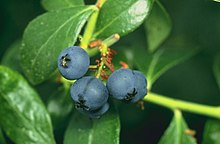
| |
| Vaccinium caesariense | |
| Scientific classification | |
| Kingdom: | Plantae |
| Clade: | Tracheophytes |
| Clade: | Angiosperms |
| Clade: | Eudicots |
| Clade: | Asterids |
| Order: | Ericales |
| Family: | Ericaceae |
| Genus: | Vaccinium |
| Section: | Vaccinium sect. Cyanococcus Rydb. |
| Species | |
|
See text | |

Blueberry is a widely distributed and widespread group of
Blueberries are usually prostrate shrubs that can vary in size from 10 centimeters (4 inches) to 4 meters (13 feet) in height. In commercial production of blueberries, the species with small, pea-size berries growing on low-level bushes are known as "lowbush blueberries" (synonymous with "wild"), while the species with larger berries growing on taller, cultivated bushes are known as "highbush blueberries". Canada is the leading producer of lowbush blueberries, while the United States produces some 40% of the world supply of highbush blueberries.
Origin and history of cultivation
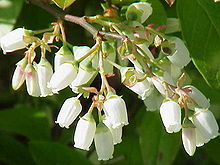

The genus Vaccinium has a mostly circumpolar distribution, with species mainly present in North America, Europe, and Asia.[1] Many commercially available species with English common names including "blueberry" are from North America,[3] particularly Atlantic Canada and the northeastern United States for wild (lowbush) blueberries, and several US states and British Columbia for cultivated (highbush) blueberries.[4][5] First Nations peoples of Canada consumed wild blueberries for millennia.[4] Highbush blueberries were first cultivated in New Jersey around the beginning of the 20th century.[5][3]
North American native species of blueberries are grown commercially in the Southern Hemisphere in Australia, New Zealand and South American nations. The Colombian or Andean blueberry,
Description
Five species of blueberries grow wild in Canada, including Vaccinium myrtilloides, Vaccinium angustifolium and Vaccinium corymbosum, which grow on forest floors or near swamps.[7] Wild (lowbush) blueberries are not planted by farmers, but rather are managed on berry fields called "barrens".[4]
Wild blueberries reproduce by
Highbush (cultivated) blueberries prefer sandy or
are bell-shaped, white, pale pink or red, sometimes tinged greenish.The fruit is a berry 5–16 mm (3⁄16–5⁄8 in) in diameter with a flared crown at the end; they are pale greenish at first, then reddish-purple, and finally uniformly blue when ripe.[8] They are covered in a protective coating of powdery epicuticular wax, colloquially known as the "bloom".[7] They generally have a sweet taste when mature, with variable acidity.[7][8] Blueberry bushes typically bear fruit in the middle of the growing season: fruiting times are affected by local conditions such as climate, altitude and latitude, so the time of harvest in the northern hemisphere can vary from May to August.[7][8]
Species
This section needs additional citations for verification. (March 2020) |
Note: habitat and range summaries are from the Flora of New Brunswick, published in 1986 by Harold R. Hinds, and Plants of the Pacific Northwest coast, published in 1994 by Pojar and MacKinnon.
- Vaccinium angustifolium (lowbush blueberry):[9][3] acidic barrens, bogs and clearings, Manitoba to Labrador, south to Nova Scotia; and in the United States, from Maine westward to Iowa and southward to Virginia
- Vaccinium boreale (northern blueberry): peaty barrens, Quebec and Labrador (rare in New Brunswick), south to New York and Massachusetts
- Vaccinium caesariense (New Jersey blueberry)
- Vaccinium corymbosum (northern highbush blueberry)[9]
- Vaccinium darrowii (evergreen blueberry)
- Vaccinium elliottii (Elliott blueberry)
- Vaccinium formosum (southern blueberry)
- Vaccinium fuscatum (black highbush blueberry; syn. V. atrococcum)
- Vaccinium hirsutum (hairy-fruited blueberry)
- Vaccinium myrsinites (shiny blueberry)
- Vaccinium myrtilloides (sour top, velvet leaf, or Canadian blueberry)
- Vaccinium pallidum (dryland blueberry)
- Vaccinium simulatum (upland highbush blueberry)
- Vaccinium tenellum (southern blueberry)
- Vaccinium virgatum (rabbiteye blueberry; syn. V. ashei)[9]
Some other blue-fruited species of Vaccinium:
- Vaccinium koreanum (Korean blueberry)
- Vaccinium myrtillus (bilberry or European blueberry)
- Vaccinium uliginosum (bog bilberry/blueberry, northern bilberry or western blueberry)
-
Wild blueberry in autumn foliage, Pilot Mountain, North Carolina, in October
-
A maturing 'Polaris' blueberry (Vaccinium corymbosum)
-
A selection of blueberries, showing the typical sizes of the berries. The scale is marked in centimeters.
The lowbush varieties are V. angustifolium, V. boreale, V. mytilloides, V. pallidum, and V. angustifolium × V. corymbosum. They are still grown in a similar manner to pre-Columbian semi-wild cultivation, i.e.
Identification
Commercially offered blueberries are usually from species that naturally occur only in eastern and north-central North America. Other sections in the genus are native to other parts of the world, including the Pacific Northwest and southern United States,[10] South America, Europe and Asia. Other wild shrubs in many of these regions produce similar-looking edible berries, such as huckleberries and whortleberries (North America) and bilberries (Europe). These species are sometimes called "blueberries" and are sold as blueberry jam or other products.
The names of blueberries in languages other than English often translate as "blueberry", e.g.
Cyanococcus blueberries can be distinguished from the nearly identical-looking bilberries by their flesh color when cut in half. Ripe blueberries have light green flesh, while bilberries, whortleberries and huckleberries are red or purple throughout.
 A dish of blueberries | |
| Nutritional value per 100 g (3.5 oz) | |
|---|---|
| Energy | 240 kJ (57 kcal) |
14.49 g | |
| Sugars | 9.96 g |
| Dietary fiber | 2.4 g |
0.33 g | |
0.74 g | |
Niacin (B3) | 3% 0.418 mg |
| Pantothenic acid (B5) | 2% 0.124 mg |
| Vitamin B6 | 3% 0.052 mg |
| Folate (B9) | 2% 6 μg |
| Vitamin C | 11% 9.7 mg |
| Vitamin E | 4% 0.57 mg |
| Vitamin K | 16% 19.3 μg |
| Minerals | Quantity %DV† |
| Calcium | 0% 6 mg |
| Iron | 2% 0.28 mg |
| Magnesium | 1% 6 mg |
| Manganese | 15% 0.336 mg |
| Phosphorus | 1% 12 mg |
| Potassium | 3% 77 mg |
| Sodium | 0% 1 mg |
| Zinc | 2% 0.165 mg |
| Other constituents | Quantity |
| Water | 84 g |
| †Percentages estimated using US recommendations for adults,[11] except for potassium, which is estimated based on expert recommendation from the National Academies.[12] | |
Culinary use
Blueberries are sold fresh or are processed as
Blueberry jam is made from blueberries, sugar, water, and fruit pectin. Blueberry sauce is a sweet sauce prepared using blueberries as a primary ingredient.
Blueberry wine is made from the flesh and skin of the berries, which is fermented and then matured; usually the lowbush variety is used.
Nutrients
Blueberries consist of 14%
Phytochemicals and research
Blueberries contain anthocyanins, other polyphenols and various phytochemicals under preliminary research for their potential biological effects.[13] Most polyphenol studies have been conducted using the highbush cultivar of blueberries (V. corymbosum), while content of polyphenols and anthocyanins in lowbush (wild) blueberries (V. angustifolium) exceeds values found in highbush cultivars.[14]
-
A cut blueberry showing how, having been frozen and then thawed, thepericarp are able to run into the damaged cells, staining the flesh.
-
Structure of anthocyanins, the blue pigments in blueberries.[13]
Cultivation

Blueberries may be cultivated, or they may be picked from semiwild or wild bushes. In North America, the most common cultivated species is V. corymbosum, the
So-called "wild" (lowbush) blueberries, smaller than cultivated highbush ones, have intense color. The
"Wild" has been adopted as a marketing term for harvests of managed native stands of lowbush blueberries. The bushes are not planted or selectively bred, but they are pruned or burned over every two years, and pests are "managed".[16]
Numerous highbush
The
Successful blueberry cultivation requires attention to
Blueberry bushes often require supplemental fertilization,[23] but over-fertilization with nitrogen can damage plant health, as evidenced by nitrogen-burn visible on the leaves.[22][23]
Growing regions
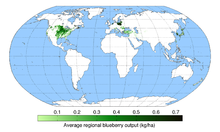
Significant production of highbush blueberries occurs in
United States
In 2018,
Hammonton, New Jersey, claims to be the "Blueberry Capital of the World",[28] with over 80% of New Jersey's cultivated blueberries coming from this town.[29] Every year the town hosts a large festival, which draws thousands of people to celebrate the fruit.[30]
Maine is known for its wild blueberries,[31] but the state's lowbush (wild) and highbush blueberries combined account for 10% of all blueberries grown in North America. Some 44,000 hectares (110,000 acres) are farmed, but only half of this acreage is harvested each year due to variations in pruning practices.[32] The wild blueberry is the official fruit of Maine.[33]
Canada

Canadian production of wild and cultivated blueberries in 2015 was 166,000 tonnes valued at $262 million, the largest fruit crop produced nationally accounting for 29% of all fruit value.[34]
British Columbia was the largest Canadian producer of cultivated blueberries, yielding 70,000 tonnes in 2015,[34] the world's largest production of blueberries by region.[35]
Québec is a major producer of wild blueberries, especially in the regions of
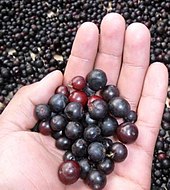
Europe
Highbush blueberries were first introduced to Germany, Sweden and the Netherlands in the 1930s, and have since been spread to numerous other countries of Europe.[2] V. corymbosum only began to be cultivated in Romania in a few years leading up to 2018 and rapidly increased in production and sales in that time (as with berries in general). As of 2018[update] it remains relatively unmolested by pests and diseases (see Diseases below).[41]
Southern Hemisphere
In the Southern Hemisphere, Brazil, Chile, Argentina, Peru, Uruguay, New Zealand, Australia, South Africa,[42] and Zimbabwe grow blueberries commercially.[43]
In Brazil, blueberries are produced in the states of Rio Grande do Sul, Santa Catarina, Paraná, São Paulo and Minas Gerais.[44]
Blueberries were first introduced to Australia in the 1950s, but the effort was unsuccessful. In the early 1970s, the Victorian Department of Agriculture imported seed from the U.S. and a selection trial was started. This work was continued into the mid-1970s when the Australian Blueberry Growers' Association was formed.[45]
In the 21st century, the industry grew in
Pests and diseases
Diseases
As of 2018[update] V. corymbosum remains relatively unmolested by pests and diseases in Romania, with
Pest management
Pesticides
DDT began to be used in blueberry soon after its discovery in 1939, and a few years later in the mid-1940s research began into its use in North America.[3]
Because "wild" is a marketing term generally used for all low-bush blueberries, it is not an indication that such blueberries are free from pesticides.[49]
Insecticide modes of action must be varied to avoid encouraging resistance in the invasive pest Drosophila suzukii.[3]
Some
Integrated pest management
Blueberries are naturally relatively unmolested by
Changes in locale and environment – to new geographies, and into
International quarantine
Rhagoletis mendax is a
Resistant cultivars
Insect resistance was not a priority in
Production
| Country | Production (tonnes) |
|---|---|
| 351,130 | |
| 227,971 | |
| 146,551 | |
| 122,795 | |
| 66,482 | |
| 61,230 | |
| World | 1,113,261 |
| Source: FAOSTAT of the United Nations[50]
| |
In 2021, world production of blueberries (lowbush and highbush combined) was 1.1 million tonnes, led by the United States with 32% of global production, Peru with 20%, and Canada with 13% (table).[50]
In 2019, Canada was the largest producer of wild blueberries, mainly in
Regulations
Canada
Canada No. 1 blueberries are all similar in size, shape, weight, and color—the total product can be no more than ten percent off-color and three percent otherwise defective.[53]
See also
References
- ^ ISBN 0-85199-066-5. Archivedfrom the original on December 12, 2020. Retrieved September 21, 2020.
- ^ from the original on March 11, 2007. Retrieved August 25, 2006.
- ^ S2CID 58573080.
- ^ a b c "Canadian blueberries". Agriculture and Agri-Food Canada, Government of Canada. August 9, 2018. Archived from the original on February 20, 2020. Retrieved February 5, 2020.
- ^ a b "Blueberries – Celebrating 100 Years". Blueberry.org. US Highbush Blueberry Council. 2020. Archived from the original on April 9, 2020. Retrieved February 5, 2020.
- ^ Foster, Steven (2012). "The Adulteration of Commercial Bilberry Extracts" (PDF). Academia. Archived from the original (PDF) on May 16, 2021. Retrieved May 16, 2021 – via Herbalgram.
- ^ a b c d e f g h i j k "Wild Blueberry Fact Sheet A.2.0. Growth and Development of the Wild Blueberry" (PDF). Agriculture, Aquaculture and Fisheries, Province of New Brunswick, Canada. Archived (PDF) from the original on July 17, 2017. Retrieved February 5, 2020.
- ^ a b c d Becky Sideman (August 1, 2016). "Growing fruit: Highbush blueberries" (PDF). University of New Hampshire Cooperative Extension. Archived (PDF) from the original on September 25, 2020. Retrieved February 5, 2020.
- ^ PMID 30254656.
- ^ "Plants Profile: Vaccinium corymbosum L., Highbush blueberry". US Department of Agriculture, National Resources Conservation Service. 2013. Archived from the original on May 2, 2013. Retrieved April 30, 2013.
- ^ United States Food and Drug Administration (2024). "Daily Value on the Nutrition and Supplement Facts Labels". Retrieved March 28, 2024.
- )
- ^ a b "Flavonoids". Micronutrient Information Center, Linus Pauling Institute, Oregon State University, Corvallis, OR. November 2015. Archived from the original on October 24, 2019. Retrieved December 25, 2017.
- PMID 11600018.
- ^ "Growing Highbush Blueberries" (PDF). University of New Hampshire-Extension. Archived (PDF) from the original on September 27, 2013. Retrieved September 22, 2013.
- ^ "Wild Blueberry Network Information Centre". Wild Blueberry Network Information Centre. Archived from the original on October 15, 2018. Retrieved October 15, 2018.
- ^ "Blueberry Growing Comes to the National Agricultural Library". US Department of Agriculture, Agricultural Research Magazine, Vol. 59, No. 5. June 2011. Archived from the original on July 9, 2011. Retrieved June 17, 2011.
- ^ a b "The History of Whitesbog Village". Whitesbog.org. 2014. Archived from the original on May 15, 2008. Retrieved October 11, 2011.
- ^ Mirsky, Steve. "Early 20th Century Botanist Gave Us Domesticated Blueberries". Scientific American. Archived from the original on September 27, 2013. Retrieved September 21, 2013.
- ^ Jim Minick (June 29, 2016). "The Delicious Origins of The Domesticated Blueberry". JSTOR News. Archived from the original on February 8, 2018. Retrieved June 30, 2016.
- ^ Monte Nesbitt; Jim Kamas; Larry Stein (2013). "Blueberries" (PDF). Texas A&M University, AgriLife Extension Service. Archived (PDF) from the original on September 5, 2019. Retrieved April 27, 2019.
- ^ a b Longstroth M (2014). "Lowering the soil pH with sulfur" (PDF). Michigan State University. Archived from the original (PDF) on November 16, 2015. Retrieved August 24, 2015.
- ^ a b c Hayden RA (2001). "Fertilizing blueberries" (PDF). Purdue University, Department of Horticulture. Archived (PDF) from the original on October 11, 2015. Retrieved September 5, 2015.
- ^ "Cornell fruit: berry diagnostic tool". Cornell University, Department of Horticulture. 2013. Archived from the original on September 12, 2015. Retrieved September 5, 2015.
- ^ "Where Are Blueberries Grown?". World Atlas. April 25, 2017. Archived from the original on April 27, 2019. Retrieved April 27, 2019.
- ^ Mitch Lies (December 31, 2018). "Record year makes Oregon top blueberry producer". Capital Press. Salem, OR. Archived from the original on April 27, 2019. Retrieved April 27, 2019.
- ^ "Top 10 Blueberry Producing States In America". World Atlas. 2019. Archived from the original on April 27, 2019. Retrieved April 27, 2019.
- ^ "Home: Welcome to the Town of Hammonton". Town of Hammonton. September 11, 2013. Archived from the original on November 11, 2013. Retrieved November 6, 2013.
- ^ "The Beautiful Blueberry!". Pineypower.com. 2018. Archived from the original on July 11, 2018. Retrieved July 10, 2018.
- ^ "Hammonton Chamber of Commerce". Hammontonnj.us. 2018. Archived from the original on December 12, 2020. Retrieved July 10, 2018.
- ^ "Maine's Famous Blue Fruit", Maine Office of Tourism; accessed 2022.01.22.
- ^ David E. Yarborough (February 2015). "Wild Blueberry Culture in Maine". Cooperative Extension: Maine Wild Blueberries, University of Maine. Archived from the original on March 6, 2016. Retrieved April 20, 2016.
- ^ "State Berry – Wild Blueberry". Secretary of State for Maine, Matthew Dunlap. 2007. Archived from the original on September 24, 2017. Retrieved July 8, 2017.
- ^ a b "Fruit and vegetable production, 2015 – Canada". Statistics Canada. February 3, 2016. Archived from the original on June 11, 2016. Retrieved May 18, 2016.
- ^ "British Columbia Blueberries". BC Blueberry Council. 2009. Archived from the original on October 23, 2013. Retrieved November 6, 2013.
- ^ Deschênes V (April 20, 2016). "New Brunswick to become world's largest producer of wild blueberries". Government of New Brunswick, Department of Agriculture, Aquaculture and Fisheries. Archived from the original on June 24, 2016. Retrieved May 18, 2016.
- ^ Dorff E (November 30, 2015). "Blueberry varieties – Canada. In: The changing face of the Canadian fruit and vegetable sector: 1941 to 2011". Statistics Canada. Archived from the original on June 10, 2016. Retrieved May 18, 2016.
- ^ Nova Scotia: Official emblems and symbols Archived February 13, 2007, at the Wayback Machine
- ^ "Wild blueberry trivia". Wild Blueberry Producers Associations of Nova Scotia. 2016. Archived from the original on May 24, 2016. Retrieved May 18, 2016.
- ^ a b c Gagnon A (2006). "Wild Blueberry Production Guide in a Context of Sustainable Development: Survey of the Wild Blueberry Industry in Québec" (PDF). Ministère de l'Agriculture, des Pêcheries et de l'Alimentation du Québec. Archived (PDF) from the original on February 4, 2015. Retrieved February 4, 2015.
- ^ a b Slav, M.; Hoza, D.; Asănică, A. (2018). "Researches on the presence and aggressivity of the blueberry root rot (Phytophthora cinnamomi) in a Dâmbovița county plantation". Journal of Horticulture, Forestry and Biotechnology. 22 (4): 7–12. ref.15
- ^ "Where blueberries grow". Blueberry.org. U.S. Highbush Blueberry Council. 2019. Archived from the original on July 28, 2020. Retrieved July 27, 2020.
- ^ "Harvesting commences at one of Zimbabwe's bigger blueberry projects". The Zimbabwean. July 3, 2020. Archived from the original on August 12, 2020. Retrieved November 20, 2020.
- ^ Cultivar, Grupo. "Propagação eficiente de mirtilo". Grupo Cultivar (in Brazilian Portuguese). Retrieved March 8, 2021.
- ^ "Australian Blueberry Growers' Association". Australianblueberries.com.au. Archived from the original on September 6, 2013. Retrieved November 6, 2013.
- ^ U.S. Department of Agriculture GAIN Report Archived October 16, 2008, at the Wayback Machine, Retrieved June 30, 2011
- ^ Pirovano, Francisco (January 12, 2005). "Argentina Blueberries Voluntary 2005". GAIN Report. Foreign Agricultural Service. Archived from the original on October 16, 2008. Retrieved June 22, 2009.
- ^ "List of Goods Produced by Child Labor or Forced Labor". dol.gov. Archived from the original on June 10, 2015. Retrieved January 9, 2015.
- ^ "Catching the Toxic Drift: How Pesticides Used in the Blueberry Industry Threaten Our Communities, Our Water and the Environment". Environment Maine. August 16, 2005. Archived from the original on March 1, 2011. Retrieved October 11, 2011.
- ^ a b "Blueberry production in 2021; Crops/Regions/World list/Production Quantity (pick lists)". UN Food and Agriculture Organization, Corporate Statistical Database (FAOSTAT). 2023. Retrieved November 27, 2023.
- ^ a b "Canadian blueberries". Agriculture and Agri-Food Canada, Government of Canada. August 9, 2019. Archived from the original on June 9, 2019. Retrieved February 21, 2020.
- ^ "Blueberries: transitioning from wild to cultivated production". Charlottetown Research and Development Centre, Agriculture and Agri-Food Canada, Government of Canada. January 31, 2018. Archived from the original on December 16, 2019. Retrieved March 18, 2019.
- ^ Government of Canada, Canadian Food Inspection Agency (March 2, 2018). "Grades and Requirements for Blueberries; In: Canadian Grade Compendium; Volume 2 – Fresh Fruit or Vegetables". inspection.gc.ca. Archived from the original on April 29, 2019. Retrieved July 12, 2019.
Further reading
- Retamales, J. B., Hancock, J. F. (2012). Blueberries (Crop Production Science in Horticulture). CABI. ISBN 978-1-84593-826-0
- Sumner, Judith (2004). American Household Botany: A History of Useful Plants, 1620–1900. Timber Press. p. 125. ISBN 0-88192-652-3.
- Wright, Virginia (2011). The Wild Blueberry Book. Down East Books. ISBN 978-0-89272-939-5.


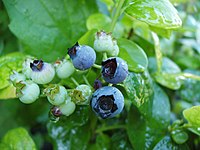

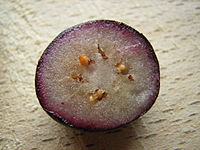
![Structure of anthocyanins, the blue pigments in blueberries.[13]](http://upload.wikimedia.org/wikipedia/commons/thumb/c/cd/Anthocyanidine.svg/200px-Anthocyanidine.svg.png)
